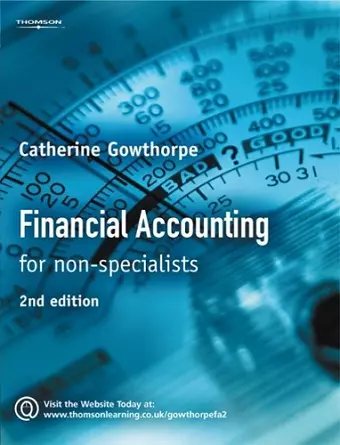Financial Accounting
For Non Specialists
Format:Paperback
Publisher:Cengage Learning EMEA
Published:6th Jun '05
Currently unavailable, and unfortunately no date known when it will be back

Financial Accounting for Non Specialists is aimed at non-specialist students of accounting and finance on a first course in the subject. It gives a lively and wide-ranging survey of the basic principles of finance and financial accounting. The unique approach taken in the first Section of the book is to look at small to medium sized business organisations and their role in the economy – how they are set up, factors in their success and failure and how they source funds for expansion. This leads to discussion of the role of financial markets and their need for financial information. Section 2 then gives an account of financial accounting principles. The text is clearly written and technical jargon is minimal - any technical terms are clearly explained and a glossary of terms is provided. The book does not present the hurdle of double-entry bookkeeping at an early stage – students can progress through the book without double-entry. Illustrative case studies and reference to real-life business examples are used to bring the technical information to life. Financial Accounting for Non-specialists includes a large number of worked examples, to give students valuable practice in using their new skills. Other pedagogic elements include aims and learning outcomes, summaries, Case Studies with questions and solutions, individual learning activities, self-test questions with answers provided in the book, and exercises - the answers to which are divided between the book and the Lecturer’s Guide/Website.
SECTION 1 ? Introduction and background to commercial business organisations CHAPTER 1 Introduction to business organisations and finance Forms of business organisation. Sole traders, limited companies and partnerships contrasted. Finance for business. Fundamentals of taxation. CHAPTER 2 Starting a business Financing the small business. The business plan. Why do businesses fail (and why do some of them succeed)? CHAPTER 3 The growing business Stages in business growth and expansion. Making money. Risk. CHAPTER 4 Large businesses Sources of finance for companies. The UK Stock Market. Organisation and operation of the London Stock Exchange. Flotation and other share issues. To list or not to list? The role of information in stock markets. CHAPTER 5 The role of accounting in business The need for accounting information. Users of accounting information. Characteristics of useful financial information. Financial accounting and management accounting. The role of the accountant in business organisations. Why do business managers have to understand accounting reports? SECTION 2 ? Financial accounting CHAPTER 6 The balance sheet Balance sheet basics. The accounting equation. Drawing up a balance sheet. More practice with balance sheets. CHAPTER 7 The profit and loss account Profit and loss. Categories of commercial activity. Profit and loss account for a sole trader. Movements in stock. Calculating cost of sales. Calculating net profit. What does the profit and loss account mean? Profit and loss accounting in a service business. Preparing the profit and loss account and balance sheet. CHAPTER 8 Adjustments to the profit and loss account and balance sheet ? part 1 Some further complexities in preparing the profit and loss account. Comprehensive example. Accounting conventions. Current asset adjustments. CHAPTER 9 Adjustment to the profit and loss account and balance sheet ? part 2 Depreciation and amortisation. Impact of depreciation on the accounts. Intangible assets and amortisation. Accounting for amortisation. Another method of depreciation. Sale of a fixed asset. Buying and selling assets during the year. CHAPTER 10 Cash flow The role of cash in business. Mismanagement of working capital. The distinction between profit and cash. Preparing a cash flow statement. Direct and indirect approaches to cash flow. The ?direct? method explained. Cash flow statements in an established business. The high profit/no cash paradox. CHAPTER 11 Financial reporting by limited companies Introduction to accounting by limited companies. Regulation of company accounting and other issues. Accounting for limited companies. Accounting for listed companies: additional requirements. CHAPTER 12 Analysing and understanding financial reports: Part 1 ? analysis of trends Usefulness of financial reports to various interest groups. Analytical techniques: changes in figures. Analytical techniques: changes in figures. Analytical techniques: horizontal and trend analysis. Analytical techniques: vertical analysis and common size analysis. Comparing businesses with each other. CHAPTER 13 Analysing and understanding financial reports: Part 2 ? analysis using accounting ratios. Financial ratio analysis techniques. Performance ratios. Liquidity ratios. Efficiency ratios. Investor ratios. Lending ratios. Index Answers to Self-test Questions Answers to Exercises
ISBN: 9781844802050
Dimensions: 17mm x 185mm x 243mm
Weight: 740g
416 pages
2nd edition